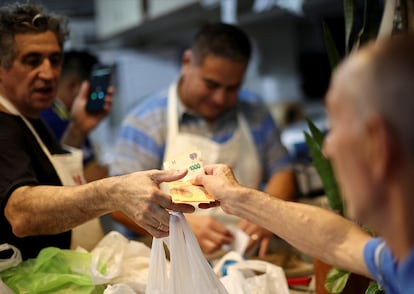There are plenty of banknotes in Argentina, yet Argentines are not rich
Inflation has devastated the value of the peso and the highest denomination bill is worth just a little over $10


There are 11.9 billion banknotes in circulation in Argentina. A quick calculation gives an idea of what this means: every Argentine citizen — and we are even counting children here — could have 258 bills of different denominations in his or her pocket. A similar calculation results in 68 bills per inhabitant in Chile, and 35 in Brazil. Yet this does not make Argentines richer.
It so happens that the highest denomination bill in Argentina is 10,000 pesos. It has only been on the streets for four months and it is worth $10.20 at the official exchange rate and $7.70 on the black market. Finding them is a detective’s job. On the other hand, 1,000-peso bills are abundant and have been available since 2017. There are 6.2 billion of them, accounting for more than half of the bills in circulation. The value of these orange-hued bills bearing the face of the independence leader José de San Martín is just 76 cents on the black market and 97 cents on the government-regulated exchange rate.
Argentina is not a cheap country in dollars, as one might think. To pay for a coffee in a bar, you will need, depending on the place, three thousand-peso bills, about three dollars at the official exchange rate (there are also more expensive places). A dinner for two at a moderately priced restaurant will require about 40 bills. Things get more complicated when you go for groceries at the supermarket: 150,000 pesos will be spent there without a doubt. Thinking of getting a new cell phone? You will have to spend between 300,000 and 1.5 million pesos for it. And in addition to the price of a second-hand car, you will have to pay for a suitcase to carry the money in: a low-end two-door car that is five years old costs 15 million pesos, that is, 15,000 thousand-peso bills.
Most of these transactions, of course, can be made with a virtual wallet, a form of payment that skyrocketed after the pandemic, reaching 65% of the population. But as the economic crisis worsens, more and more businesses are offering discounts for cash payments, or not accepting credit cards at all, in order to avoid bank and operator fees. For high-value transactions such as a car or an apartment, it is best to buy in dollars. Since there are very strict exchange restrictions in place, this will have to be done on the black market, at a rate of 1,300 pesos per dollar, and in cash, of course. A suitcase full of bills will be inevitable.
The root of the problem is the inflation that is devastating the Argentine economy. Between 2014 and 2021, the annual average was 50%. In 2022, the situation began to get out of control and the Consumer Price Index (CPI) climbed to 94.8%. The year 2023 ended in December with 221% inflation, and the first half of 2024 has already registered an increase of 87%. Inflation is the visible face of the loss of value of the currency. To conceal the fact that things were not going well, the different governments always delayed the printing of higher denomination currency. And so we came to the point where the most widely circulated banknote in Argentina today is not even enough to buy a piece of candy, when just seven years ago it was worth $58.
One million pesos
The problem is not new. Argentines still remember that in the late 1970s the military regime printed one-million-peso bills. Removing zeros had already become a common practice to prevent the collapse of bank and corporate balance sheets. But also, and this is the point, because of the psychological impact: as an example, the 10,000-austral bill that former president Carlos Menem inherited from Raúl Alfonsín was converted in 1992, as if by magic, into one peso, that peso being enough to buy a dollar. Between 1969 and 1992, the Argentine currency lost 23 zeros, and with each pruning, a bit of its dignity.
The government of the far-right Javier Milei has promised that 20,000 peso bills will be in circulation in October, equivalent to around $20 at the official exchange rate and just over $15 on the black market. This will be a relief, of course, but still clearly not enough.
Sign up for our weekly newsletter to get more English-language news coverage from EL PAÍS USA Edition
Tu suscripción se está usando en otro dispositivo
¿Quieres añadir otro usuario a tu suscripción?
Si continúas leyendo en este dispositivo, no se podrá leer en el otro.
FlechaTu suscripción se está usando en otro dispositivo y solo puedes acceder a EL PAÍS desde un dispositivo a la vez.
Si quieres compartir tu cuenta, cambia tu suscripción a la modalidad Premium, así podrás añadir otro usuario. Cada uno accederá con su propia cuenta de email, lo que os permitirá personalizar vuestra experiencia en EL PAÍS.
¿Tienes una suscripción de empresa? Accede aquí para contratar más cuentas.
En el caso de no saber quién está usando tu cuenta, te recomendamos cambiar tu contraseña aquí.
Si decides continuar compartiendo tu cuenta, este mensaje se mostrará en tu dispositivo y en el de la otra persona que está usando tu cuenta de forma indefinida, afectando a tu experiencia de lectura. Puedes consultar aquí los términos y condiciones de la suscripción digital.
More information
Archived In
Últimas noticias
Most viewed
- Sinaloa Cartel war is taking its toll on Los Chapitos
- Oona Chaplin: ‘I told James Cameron that I was living in a treehouse and starting a permaculture project with a friend’
- Reinhard Genzel, Nobel laureate in physics: ‘One-minute videos will never give you the truth’
- Why the price of coffee has skyrocketed: from Brazilian plantations to specialty coffee houses
- Silver prices are going crazy: This is what’s fueling the rally










































